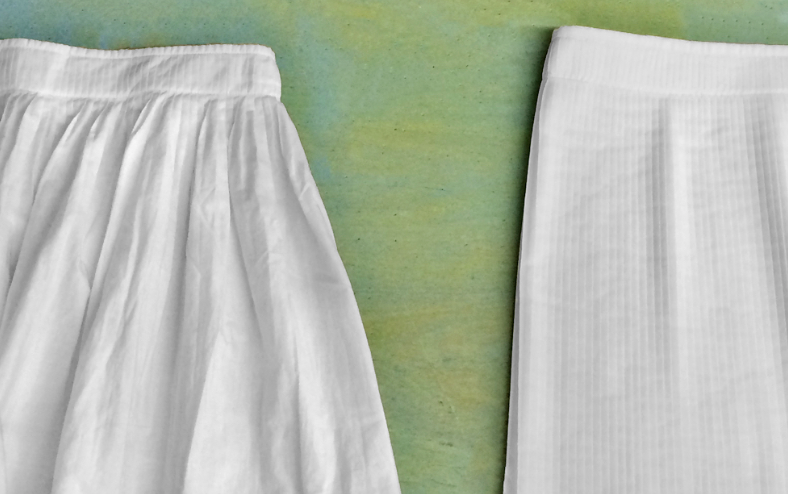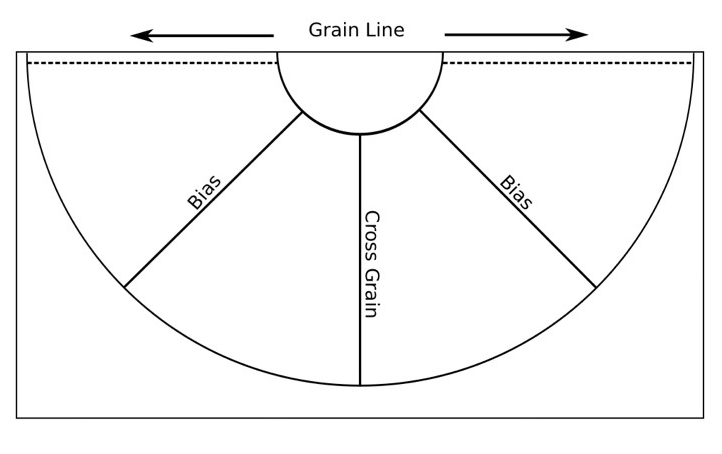
Repairing Damaged Pleats
So, you had your skirt dry cleaned and something looks a little different… Eeeek! I wish I could say I don’t get this call often! So often, in fact, I’ve decided to write a little bit about the process of restoring open pleats touching a little bit on each of the most frequently asked questions to provide as much information as possible on what to do now. So before you give up on your pleated skirt, read through this post!
Can you restore the damaged pleats in my garment?
Well… anything is possible. For repairs, however, everything is going to be case by case. If you are local, it’s always best to schedule an appointment to come in and show us the piece. This is the best way to get an idea of what the project may look like. The next best option would be to send us an email with photographs and some information about your garment.
In your email, please include the following information:
-name and size of the original pleat style (if known)
-the fabric content of the damaged pleats
-additional information on the garment construction (sewn into waistband, lining, etc.)
-how the pleats were damaged
-how much time you have for the repair
And please attach the following pictures:
-the garment on a flat surface
-the garment hanging
-close up of the pleat
-pleating beside a ruler
-the finishing (hem)
-the seam(s) the pleating is attached to
How much does it cost to restore damaged pleating?
The cost of a repair job depends on the complexity of the project. It also depends on how much of the labor you will need to have done in our studio versus what you can do on your own, or what you can have a tailor complete for you. The two most common scenarios for repairs involve either re-pleating the original fabric of the garment or pleating brand new fabric to replace the damaged pleats in the garment. In either case, the least expensive option will be to bring us fabric that is clean, flat, and ready to be pleated.
If we advise you to keep the original fabric in the garment, that means prior to the repair the garment will need to be taken apart to remove the pleated fabric. The damaged pleats will then need to be cleaned and pressed entirely flat before it can be re-pleated. This step should only be done after we have seen the images of the pleats and advise you to do so – if you jump ahead and press the pleats flat before we’ve seen it, we won’t know how to restore it!
If we advise you to purchase new fabric, we will tell you how much you will need and advise you on how the finishing should be done and whether it will need to be hemmed prior to pleating or after the pleating is completed. The trickiest part of working with a new pleated panel is cutting the appropriate piece to put back into your garment. When you take it apart to remove the damages panel, you should be able to use it as a guide.
Unfortunately, because of the amount of labor involved in this process, for many scenarios the least expensive option can be to repurchase the garment, unless it is a designer piece or something very sentimental to you. In either scenario for the repair, if you are able to deconstruct and reassemble the garment yourself, this would definitely help in lowering your cost and reducing lead time.
Depending ultimately on the amount of labor we complete here, the cost can range from less than $100 to a couple hundred dollars typically – but we have restored museum pieces that have reached the thousands! It’s too difficult to provide an accurate quote for cost without seeing the individual garment.
How long does it take to restore damaged pleating?
The time it takes to repair open pleats or re-pleat depends on the complexity of the project and again on how much of the project you need us to complete for you. If we are only doing the pleating portion for fabric that is clean, flat, and ready to be pleated, it can take as little as a few days to a week. However, this will not include the time spent taking apart the garment and putting it back together. This is also greatly influenced by the style and size of pleats needed. Certain styles take more time to complete than others.
For a project where more of the steps are completed in our studio, or for more complicated pleating, it can take closer to 2-4 weeks.
For repairs, time is also a variable in determining cost. Typically, the longer you can wait, the more affordable it will become since we can complete similar work at the same time or work around other production orders. If this is the case, plan for around 6-10 weeks for the pleating to finish.
What are some common problems with repairs?
Because in most cases we did not complete the original pleating, the results may not be exactly the same as your original garment, but we can guarantee they will be quality work! If we notice there will be any variation in size or style based on what options we have available, this is something we will discuss with you prior to taking the order.
When it comes to re-pleating the original fabric there are a few concerns. Depending on what kind of fabric needs to be pleated, sometimes the creases from the original pleating will not fully release from the fabric. Since the fabric will move in the process of being pleated, the new pleats may not fall exactly on those creases. In most cases this is not noticeable, but it can be a concern for some clients or some fabrics where it may be more noticeable.
Another problem we can find with re-pleating the original fabric is that the finished pleating may have different dimensions after being re-pleated than it had prior to being removed from the garment.If the fabric was stretched out at all during the process of being pressed open this can be an issue. If the original pleat size varied slightly from our available options, this can also influence the finished dimensions. We will always advise you on the best option to choose to get the most similar result to restore your garment, but please note this can happen.
The construction of the garment can also pose problems for restoring damaged pleats. If there is not a lot of seam allowance provided inside the garment when it is taken apart, it will be mush more difficult to sew back into your garment after it has been re-pleated.
For silks especially, color changing can also pose a problem. This is often seen in lighter colors like pinks and creams. After the pleats are set in our industrial steamer, sometimes the finishing of the fabric can cause it to change color, and unfortunately this isn’t something we can anticipate prior to completing the order. If you are pleating brand new fabric to match the garment, we usually recommend bringing two similar colors and testing first to see which will work best after steaming.
How can I prevent this from happening again?
We can definitely give you tips on how to care for your newly restored garment. Most polyester will remain pleated permanently when treated for properly. Polyester blends and other synthetics can also hold well, depending on the finishing of your specific fabric. For care, we always recommend spot cleaning first, and testing a small area of a garment prior to washing the entire piece at one time. If the fiber is able to pleat permanently, we suggest hand washing in cold water with a mild detergent, then air drying. The pleats should not be wrung out too harshly, and it should be hung to dry rather than dried on a folding rack. Any source of heat will potentially release the pleats, so no steaming and no dryers!
Natural fibers, like silk or cotton, will generally want to open up over time, especially when exposed to moisture. Certain fibers will perform better than others. In our experience cotton and rayon are the most likely to open. For these kinds of fibers, the style of pleat will also affect how easily it can be cared for or maintained over time. This is something we can advise you on if you are unsure what style or size of pleat you need. Then for aftercare, be gentle to your natural fiber pleats! If it needs to be cleaned, we suggest having these garments dry cleaned only. Your best chances are to find a high-end or luxury dry cleaner that will provide special attention to your garment. Before choosing a dry cleaner, do some research and ask questions to make sure they know how to handle pleats.


